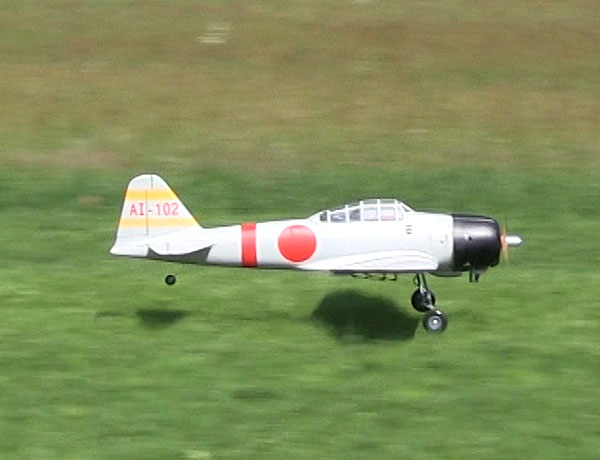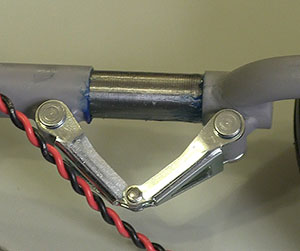



War birds pretty much suck without retracts. Robart was my only real choice.
Text, photos and video by Tom Hintz
Posted – 10-14-2015
Whenever you happen upon a discussion about retractable landing gear you will hear the name Robart and for good reason. Robart has a long-standing reputation for producing high quality air and electric-driven retracts that are as durable as they are great looking. Robart also has a long list of retracts designed to fit specific model planes to simplify installation while promising smooth, reliable operation. When I wanted to use retracts in my ESM 88” Zero I found that Robart had a set of electric mains (#ESMZERO-E) so I ordered them only to find out they were back ordered. I decided to wait and am glad I did.
I was impressed when I first saw my Robart Electric Retracts. A combination of steel and aluminum parts are all nicely made. Robart appears to let the quality of their components and manufacturing serve as the bling others use to camouflage corner cutting.
The Robart Electric Retracts have a “down” length of 8-3/8” from mount to the end of the strut. They open and close through a 90-degree swing with no rotations which makes these retracts stronger. The Robart Electric Retracts have a very scale looking offset at the end that accepts a 4”-diameter wheel and tire nicely. I am a habitual user of DuBro 4" Dia. Treaded Lightweight Wheels on my giant scale planes and they work well on the Robart Electric Retracts in my ESM 88” Zero. The retracts use a ¼”-diameter axle (bolt) so I did have to drill the wheels for that. I found the included ¼-20 bolts and nuts to be too short so picked some up locally which was no problem because of the uber-common size.
The Robart Electric Retracts feature steel oleo struts that provide about ¾” to 1” of compression that goes a long way to limiting shock delivered to the airframe when the ground sneaks up on you faster than anticipated. My ESM 88” Zero weighs 20lbs (no gas) and the compression of the Robart Electric Retracts seems perfectly balanced. I can see the wheels bumping up and down in the struts as the plane moves along the runway.
The Robart Electric Retracts set comes with a remarkably light plastic control box that gives you simple control options. The retracts each plug into this control box using a two-wire plug that can be reversed to reverse the servo direction if needed. This box also distributes power from your choice of a dedicated on-board 4.8V to 9V battery or you can power the retracts from the receiver as I did in my ESM 88” Zero. I carry a pair of 7.4V, 5000mAh packs and after the first day of flying with 5 flights with the Robart Electric Retracts I could not see any difference in the amount of power used from the batteries.
These struts have "oleo" suspension
that does a great job of taking some of
the pounding off the wing structure.
This control box also gives you the option of putting a small delay on one of the retract units. All you have to do is flip a dip switch in the box and that retract opens and closes a couple seconds after the other side begins its motion.
The decision to use electric retracts in my ESM 88” Zero was easy. I have seen too many people fighting with air-powered retracts. Chasing leaks and compromised lines seems way too common, plus you have to carry all those lines, valves and an air tank as well. Electric just seemed to be the smart bet and now after having flown them, I am very happy with that decision.
Installation of the Robart Electric Retracts is dead simple, especially with the ESM 88” Zero which is designed to use these retracts. I literally screwed them in place and ran the wires to the control box. I did have to buy extensions (12”) for the retract wires so they would comfortably reach the control box mounted on the top of the wing where it would reside inside the fuselage.
With this control box the only connection to be made when assembling the plane at the field is the one cord coming from the Gear position on the receiver. That’s it. The rest of the Robart Electric Retracts system is within the gear themselves and the control box.
In use the Robart Electric Retracts are dead simple and trouble free. They go down when I want and they come up when I want. I have a delay on one side and that also works every time with no worries or adjusting.
The oleo strut function works very well and does seem to cushion the initial landing as well as irregularities in the runway surface. On maiden day our grass field was roughly twice as tall as normal thanks to a sudden glut of rain and cooler temperatures that had the grass growing very quickly. The Robart Electric Retracts and the 4” DuBro wheels handled the tall grass better than I expected.
To say that I am happy with the Robart Electric Retracts in my ESM 88” Zero would be a major understatement. While I was sure that going with electric retracts was a good idea I still worried about having problems with them. Retracts in general get a bad rap far too often for them to be the problem all of the time. I suspect there is a good bit of user/builder error involved but those kinds of admissions will not be forthcoming.
The Robart Electric Retracts have a street price of $339.95 (10-14-2015) which certainly isn’t cheap but I don’t think it is overly expensive either considering the quality and reliability these retracts offer. If you are looking to put retracts in your next project you owe it to yourself and your new plane to check out the offerings from Robart. There is a reason why they are considered by many to be the best there is in retracts.
Visit the Robart product page – Click Here
Have a comment on this Review? –Email Me!